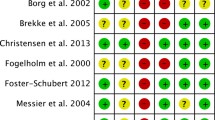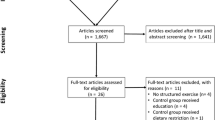Abstract
Background
Lifestyle interventions are effective for weight loss and are recommended for persons with a body mass index (BMI) of 25–40 kg m−2. However, this group is very heterogeneous, which could influence outcomes from lifestyle interventions.
Purpose
In this systematic review, differences in 1-year weight change and percentage weight change after lifestyle interventions were investigated for participants varying in initial BMI using meta-analyses.
Method
Twenty-two interventions with healthy Caucasian adults, a mean BMI between 25 and 40 kg m−2, a dietary as well as a physical activity component aiming at weight loss, and at least five contact sessions guided by a professional health care provider were selected from a systematic search in the MEDLINE database. Participants in each intervention were divided into one of the three BMI classes: overweight (BMI of 25–29.99 kg m−2), class-I obesity (BMI of 30–34.99 kg m−2), and class-II obesity (BMI of 35–39.99 kg m−2). Differences in weight change and percentage weight change were analyzed and compared among different BMI classes within the same intervention by calculating standardized mean differences.
Results
Overweight participants lost 1.1 kg less (p < 0.01) than participants with class-I obesity and 1.5 kg less (p < 0.01) than participants with class-II obesity. For percentage weight change, no significant differences were found among the BMI classes.
Conclusion
Average weight change during lifestyle interventions only differs to a small extent among people with BMI between 25 and 40 kg m−2. This implies that these interventions are equally appropriate for these BMI classes.



Similar content being viewed by others
References
Douketis JD, Macie C, Thabane L, Williamson DF. Systematic review of long-term weight loss studies in obese adults: clinical significance and applicability to clinical practice. Int J Obes (Lond). 2005;29(10):1153–67.
Curioni CC, Lourenco PM. Long-term weight loss after diet and exercise: a systematic review. Int J Obes (Lond). 2005;29(10):1168–74.
Barte JCM, Ter Bogt NCW, Bogers RP, Teixeira PJ, Blissmer B, Mori TA, et al. Maintenance of weight loss after lifestyle interventions for overweight and obesity, a systematic review. Obes Rev. 2010;11(12):899–906. doi:10.1111/j.1467-789X.2010.00740.x.
Bogers RP, Barte JCM, Schipper CMA, Vijgen SMC, de Hollander EL, Tariq L, et al. Relationship between costs of lifestyle interventions and weight loss in overweight adults. Obes Rev. 2010;11(1):51–61.
Dickinson HO, Mason JM, Nicolson DJ, Campbell F, Beyer FR, Cook JV, et al. Lifestyle interventions to reduce raised blood pressure: a systematic review of randomized controlled trials. J Hypertens. 2006;24(2):215–33. doi:10.1097/01.hjh.0000199800.72563.26.
Leon AS, Sanchez OA. Response of blood lipids to exercise training alone or combined with dietary intervention. Med Sci Sports Exerc. 2001;33(6 Suppl):S502–15. discussion S28-9.
Penedo FJ, Dahn JR. Exercise and well-being: a review of mental and physical health benefits associated with physical activity. Curr Opin Psychiatry. 2005;18(2):189–93.
Lau DC, Douketis JD, Morrison KM, Hramiak IM, Sharma AM, Ur E. 2006 Canadian clinical practice guidelines on the management and prevention of obesity in adults and children [summary]. CMAJ. 2007;176(8):S1–13. doi:10.1503/cmaj.061409.
NHLBI. Clinical guidelines on the identification, evaluation, and treatment of overweight and obesity in adults: the evidence report. National Institutes of Health. Obes Res. 1998;6 Suppl 2:51S–209.
NICE. Obesity: the prevention, identification, assessment and management of overweight and obesity in adults and children. National Institute for Health and Clinical Excellence. 2006. http://guidance.nice.org.uk/.
Georgiadis MM, Biddle SJH, Stavrou NA. Motivation for weight-loss diets: a clustering, longitudinal field study using self-esteem and self-determination theory perspectives. Health Educ J. 2006;65(1):53–72.
Inelmen EM, Toffanello ED, Enzi G, Gasparini G, Miotto F, Sergi G, et al. Predictors of drop-out in overweight and obese outpatients. Int J Obes (Lond). 2005;29(1):122–8. doi:10.1038/sj.ijo.0802846.
Bautista-Castano I, Molina-Cabrillana J, Montoya-Alonso JA, Serra-Majem L. Variables predictive of adherence to diet and physical activity recommendations in the treatment of obesity and overweight, in a group of Spanish subjects. Int J Obes Relat Metab Disord. 2004;28(5):697–705. doi:10.1038/sj.ijo.0802602.
Teixeira PJ, Going SB, Houtkooper LB, Cussler EC, Martin CJ, Metcalfe LL, et al. Weight loss readiness in middle-aged women: psychosocial predictors of success for behavioral weight reduction. J Behav Med. 2002;25(6):499–523.
Kiernan M, King AC, Kraemer HC, Stefanick ML, Killen JD. Characteristics of successful and unsuccessful dieters: an application of signal detection methodology. Ann Behav Med. 1998;20(1):1–6.
Bernier M, Avard J. Self-efficacy, outcome and attrition in a weight-reduction program. Cogn Ther Res. 1986;10:319–38.
Traverso A, Ravera G, Lagattolla V, Testa S, Adami GF. Weight loss after dieting with behavioral modification for obesity: the predicting efficiency of some psychometric data. Eat Weight Disord : EWD. 2000;5(2):102–7.
Teixeira PJ, Going SB, Sardinha LB, Lohman TG. A review of psychosocial pre-treatment predictors of weight control. Obes Rev. 2005;6(1):43–65. doi:10.1111/j.1467-789X.2005.00166.x.
Hollis JF, Gullion CM, Stevens VJ, Brantley PJ, Appel LJ, Ard JD, et al. Weight loss during the intensive intervention phase of the weight-loss maintenance trial. Am J Prev Med. 2008;35(2):118–26. doi:10.1016/j.amepre.2008.04.013.
Packianathan I, Sheikh M, Boniface D, Finer N. Predictors of programme adherence and weight loss in women in an obesity programme using meal replacements. Diabetes Obes Metab. 2005;7(4):439–47. doi:10.1111/j.1463-1326.2004.00451.x.
ter Bogt NCW, Bemelmans WJE, Beltman FW, Broer J, Smit AJ, van der Meer K. Preventing weight gain: one-year results of a randomized lifestyle intervention. Am J Prev Med. 2009;37(4):270–7.
West DS, Elaine Prewitt T, Bursac Z, Felix HC. Weight loss of black, white, and Hispanic men and women in the Diabetes Prevention Program. Obesity (Silver Spring). 2008;16(6):1413–20. doi:10.1038/oby.2008.224.
World Health Organization. Obesity: Preventing and managing the global epidemic. Geneva: WHO; 2000.
Higgins JP, Thompson SG. Quantifying heterogeneity in a meta-analysis. Stat Med. 2002;21(11):1539–58. doi:10.1002/sim.1186.
Higgins JP, Thompson SG, Deeks JJ, Altman DG. Measuring inconsistency in meta-analyses. BMJ. 2003;327(7414):557–60. doi:10.1136/bmj.327.7414.557.
Sterne JA, Sutton AJ, Ioannidis JP, Terrin N, Jones DR, Lau J, et al. Recommendations for examining and interpreting funnel plot asymmetry in meta-analyses of randomised controlled trials. BMJ. 2011;343:d4002.
Egger M, Davey Smith G, Schneider M, Minder C. Bias in meta-analysis detected by a simple, graphical test. BMJ. 1997;315(7109):629–34.
Acharya SD, Elci OU, Sereika SM, Music E, Styn MA, Turk MW, et al. Adherence to a behavioral weight loss treatment program enhances weight loss and improvements in biomarkers. Patient Prefer Adherence. 2009;3:151–60.
Burke V, Beilin LJ, Cutt HE, Mansour J, Wilson A, Mori TA. Effects of a lifestyle programme on ambulatory blood pressure and drug dosage in treated hypertensive patients: a randomized controlled trial. J Hypertens. 2005;23(6):1241–9.
Camhi SM, Stefanick ML, Katzmarzyk PT, Young DR. Metabolic syndrome and changes in body fat from a low-fat diet and/or exercise randomized controlled trial. Obesity (Silver Spring). 2010;18(3):548–54. doi:10.1038/oby.2009.304.
Cussler EC, Teixeira PJ, Going SB, Houtkooper LB, Metcalfe LL, Blew RM, et al. Maintenance of weight loss in overweight middle-aged women through the Internet. Obesity (Silver Spring). 2008;16(5):1052–60.
Heshka S, Anderson JW, Atkinson RL, Greenway FL, Hill JO, Phinney SD, et al. Weight loss with self-help compared with a structured commercial program: a randomized trial. JAMA. 2003;289(14):1792–8.
Jeffery RW, Wing RR, Sherwood NE, Tate DF. Physical activity and weight loss: does prescribing higher physical activity goals improve outcome? Am J Clin Nutr. 2003;78(4):684–9.
Kuller LH, Kinzel LS, Pettee KK, Kriska AM, Simkin-Silverman LR, Conroy MB, et al. Lifestyle intervention and coronary heart disease risk factor changes over 18 months in postmenopausal women: the Women On the Move through Activity and Nutrition (WOMAN study) clinical trial. J Womens Health (Larchmt). 2006;15(8):962–74. doi:10.1089/jwh.2006.15.962.
Obarzanek E, Vollmer WM, Lin PH, Cooper LS, Young DR, Ard JD, et al. Effects of individual components of multiple behavior changes: the PREMIER trial. Am J Health Behav. 2007;31(5):545–60. doi:10.5555/ajhb.2007.31.5.545.
Reseland JE, Anderssen SA, Solvoll K, Hjermann I, Urdal P, Holme I, et al. Effect of long-term changes in diet and exercise on plasma leptin concentrations. Am J Clin Nutr. 2001;73(2):240–5.
Rock CL, Flatt SW, Sherwood NE, Karanja N, Pakiz B, Thomson CA. Effect of a free prepared meal and incentivized weight loss program on weight loss and weight loss maintenance in obese and overweight women: a randomized controlled trial. JAMA. 2010;304(16):1803–10. doi:10.1001/jama.2010.1503.
Sacks FM, Bray GA, Carey VJ, Smith SR, Ryan DH, Anton SD, et al. Comparison of weight-loss diets with different compositions of fat, protein, and carbohydrates. N Engl J Med. 2009;360(9):859–73.
Svetkey LP, Pollak KI, Yancy Jr WS, Dolor RJ, Batch BC, Samsa G, et al. Hypertension improvement project: randomized trial of quality improvement for physicians and lifestyle modification for patients. Hypertension. 2009;54(6):1226–33. doi:10.1161/HYPERTENSIONAHA.109.134874.
Yeh MC, Rodriguez E, Nawaz H, Gonzalez M, Nakamoto D, Katz DL. Technical skills for weight loss: 2-y follow-up results of a randomized trial. Int J Obes Relat Metab Disord. 2003;27(12):1500–6. doi:10.1038/sj.ijo.0802430.
Kromhout D, Menotti A, Kesteloot H, Sans S. Prevention of coronary heart disease by diet and lifestyle: evidence from prospective cross-cultural, cohort, and intervention studies. Circulation. 2002;105(7):893–8.
Wylie-Rosett J, Herman WH, Goldberg RB. Lifestyle intervention to prevent diabetes: intensive and cost effective. Curr Opin Lipidol. 2006;17(1):37–44.
Pritchett AM, Foreyt JP, Mann DL. Treatment of the metabolic syndrome: the impact of lifestyle modification. Curr Atheroscler Rep. 2005;7(2):95–102.
Barte JCM, Ter Bogt NCW, Beltman FW, van der Meer K, Bemelmans WJE. Process evaluation of a lifestyle intervention in primary care: implementation issues and the participants’ satisfaction of the GOAL study. Health Educ Behav. 2012;39(5):564–73. doi:10.1177/1090198111422936).
Moroshko I, Brennan L, O’Brien P. Predictors of dropout in weight loss interventions: a systematic review of the literature. Obes Rev. 2011;12(11):912–34. doi:10.1111/j.1467-789X.2011.00915.x.
Author information
Authors and Affiliations
Corresponding author
Rights and permissions
About this article
Cite this article
Barte, J.C.M., Veldwijk, J., Teixeira, P.J. et al. Differences in Weight Loss Across Different BMI Classes:A Meta-analysis of the Effects of Interventions with Diet and Exercise. Int.J. Behav. Med. 21, 784–793 (2014). https://doi.org/10.1007/s12529-013-9355-5
Published:
Issue Date:
DOI: https://doi.org/10.1007/s12529-013-9355-5




